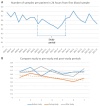Machine learning in diagnostic support in medical emergency departments
- PMID: 39095565
- PMCID: PMC11297196
- DOI: 10.1038/s41598-024-66837-w
Machine learning in diagnostic support in medical emergency departments
Abstract
Diagnosing patients in the medical emergency department is complex and this is expected to increase in many countries due to an ageing population. In this study we investigate the feasibility of training machine learning algorithms to assist physicians handling the complex situation in the medical emergency departments. This is expected to reduce diagnostic errors and improve patient logistics and outcome. We included a total of 9,190 consecutive patient admissions diagnosed and treated in two hospitals in this cohort study. Patients had a biochemical workup including blood and urine analyses on clinical decision totaling 260 analyses. After adding nurse-registered data we trained 19 machine learning algorithms on a random 80% sample of the patients and validated the results on the remaining 20%. We trained algorithms for 19 different patient outcomes including the main outcomes death in 7 (Area under the Curve (AUC) 91.4%) and 30 days (AUC 91.3%) and safe-discharge(AUC 87.3%). The various algorithms obtained areas under the Receiver Operating Characteristics -curves in the range of 71.8-96.3% in the holdout cohort (68.3-98.2% in the training cohort). Performing this list of biochemical analyses at admission also reduced the number of subsequent venipunctures within 24 h from patient admittance by 22%. We have shown that it is possible to develop a list of machine-learning algorithms with high AUC for use in medical emergency departments. Moreover, the study showed that it is possible to reduce the number of venipunctures in this cohort.
© 2024. The Author(s).
Conflict of interest statement
ESA received PhD-grant from The Region of Southern Denmark. All other authors do not have any competing interests.
Figures



References
-
- Newman-Toker, D. E. et al.Diagnostic Errors in the Emergency Department: A Systematic Review (Agency for Healthcare Research and Quality, 2022). - PubMed
-
- https://www.dst.dk/en. Date Accessed 16 February 2023 (Statistics Denmark).
MeSH terms
Grants and funding
LinkOut - more resources
Full Text Sources

